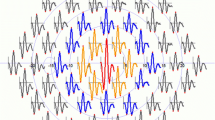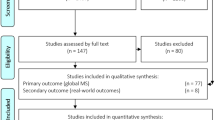Abstract
Age-related macular degeneration (AMD) is affecting an increasing number of people, with 2.95 million people estimated to be affected in the USA by 2020. Possible preventive agents, such as vitamins and supplements have been studied and new treatment options for AMD have been developed in recent years. What role does electrophysiology play as a sensitive outcome measure? The most commonly used tests are the full-field electroretinogram (ffERG) and the multifocal ERG (mfERG). Test results from patients with AMD and reduced central vision need special attention in respect to fixation pattern, age-matched control data, and retinal luminance. Advantages, disadvantages and limitations of techniques will be considered, together with a review of published studies.
Similar content being viewed by others
References
Klein R, Klein BE, Linton KL (1992) Prevalence of age-related maculopathy. The Beaver Dam Eye Study. Ophthalmology 99:933–943
Brown GC, Brown MM, Campanella J, Beauchamp GR (2005) The cost-utility of photodynamic therapy in eyes with neovascular macular degeneration – a value-based reappraisal with 5-year data. Am J Ophthalmol 140:679–687
Coleman AL, Yu F (2008) Eye-related medicare costs for patients with age-related macular degeneration from 1995 to 1999. Ophthalmology 115:18–25
Klein R, Klein BE, Jensen SC, Meuer SM (1997) The five-year incidence and progression of age-related maculopathy: the Beaver Dam Eye Study. Ophthalmology 104:7–21
Bressler NM, Munoz B, Maguire MG et al (1995) Five-year incidence and disappearance of drusen and retinal pigment epithelial abnormalities. Waterman study. Arch Ophthalmol 113:301–308
Bressler NM, Bressler SB, Fine SL (1988) Age-related macular degeneration. Surv Ophthalmol 32:375–413
Wong T, Chakravarthy U, Klein R et al (2008) The natural history and prognosis of neovascular age-related macular degeneration: a systematic review of the literature and meta-analysis. Ophthalmology 115:116–126
Schmidt-Erfurth UM, Pruente C (2007) Management of neovascular age-related macular degeneration. Prog Retin Eye Res 26:437–451
Andreoli CM, Miller JW (2007) Anti-vascular endothelial growth factor therapy for ocular neovascular disease. Curr Opin Ophthalmol 18:502–508
Ferris FL 3rd, Kassoff A, Bresnick GH, Bailey I (1982) New visual acuity charts for clinical research. Am J Ophthalmol 94:91–96
Birch DG, Anderson JL (1992) Standardized full-field electroretinography. Normal values and their variation with age. Arch Ophthalmol 110:1571–1576
Weleber RG (1981) The effect of age on human cone and rod Ganzfeld electroretinograms. Invest Ophthalmol Vis Sci 20:392–399
Wright CE, Williams DE, Drasdo N, Harding GFA (1985) The influence of age on the electroretinogram and visual evoked potential. Doc Ophthalmol 59:365–384
Seeliger MW, Kretschmann UH, Apfelstaedt-Sylla E, Zrenner E (1998) Implicit time topography of multifocal electroretinograms. Invest Ophthalmol Vis Sci 39:718–723
Fortune B, Johnson CA (2002) The decline of photopic multifocal electroretinogram responses with age is primarily due to pre-retinal optical factors. J Opt Soc Am A 19:173–184
Gerth C, Garcia SM, Ma L et al (2002) Multifocal electroretinogram: age-related changes for different luminance levels. Graefes Arch Clin Exp Ophthalmol 240:202–208
Tzekov RT, Gerth C, Werner JS (2004) Senescence of human multifocal electroretinogram components: a localized approach. Graefes Arch Clin Exp Ophthalmol 242:549–560
Jackson GR, McGwin G Jr, Phillips JM et al (2004) Impact of aging and age-related maculopathy on activation of the a-wave of the rod-mediated electroretinogram. Invest Ophthalmol Vis Sci 45:3271–3278
Hogg RE, Chakravarthy U (2006) Visual function and dysfunction in early and late age-related maculopathy. Prog Retin Eye Res 25:249–276
Medeiros NE, Curcio CA (2001) Preservation of ganglion cell layer neurons in age-related macular degeneration. Invest Ophthalmol Vis Sci 42:795–803
Curcio CA, Medeiros NE, Millican CL (1996) Photoreceptor loss in age-related macular degeneration. Invest Ophthalmol Vis Sci 37:1236–1249
Jackson GR, McGwin G Jr, Phillips JM et al (2006) Impact of aging and age-related maculopathy on inactivation of the a-wave of the rod-mediated electroretinogram. Vision Res 46:1422–1431
Feigl B, Brown B, Lovie-Kitchin J, Swann P (2005) Cone- and rod-mediated multifocal electroretinogram in early age-related maculopathy. Eye 19:431–441
Chen C, Wu L, Wu D et al (2004) The local cone and rod system function in early age-related macular degeneration. Doc Ophthalmol 109:1–8
Ronan S, Nusinowitz S, Swaroop A, Heckenlively JR (2006) Senile panretinal cone dysfunction in age-related macular degeneration (AMD): a report of 52 AMD patients compared to age-matched controls. Trans Am Ophthalmol Soc 104:232–240
Walter P, Widder RA, Luke C et al (1999) Electrophysiological abnormalities in age-related macular degeneration. Graefes Arch Clin Exp Ophthalmol 237:962–968
Sandberg MA, Miller S, Gaudio AR (1993) Foveal cone ERGs in fellow eyes of patients with unilateral neovascular age-related macular degeneration. Invest Ophthalmol Vis Sci 34:3477–3480
Falsini B, Serrao S, Fadda A et al (1999) Focal electroretinograms and fundus appearance in nonexudative age-related macular degeneration. Quantitative relationship between retinal morphology and function. Graefes Arch Clin Exp Ophthalmol 237:193–200
Gerth C, Hauser D, Delahunt PB et al (2003) Assessment of multifocal electroretinogram abnormalities and their relation to morphologic characteristics in patients with large drusen. Arch Ophthalmol 121:1404–1414
Takiura K, Yuzawa M, Miyasaka S (2001) Multifocal electroretinogram in patients with soft drusen in the macula. Invest Ophthalmol Vis Sci 42:S73
Gerth C, Delahunt PB, Alam S et al (2006) Cone-mediated multifocal electroretinogram in age-related macular degeneration: progression over a long-term follow-up. Arch Ophthalmol 124:345–352
Jurklies B, Weismann M, Husing J et al (2002) Monitoring retinal function in neovascular maculopathy using multifocal electroretinography—early and long-term correlation with clinical findings. Graefes Arch Clin Exp Ophthalmol 240:244–264
Neveu MM, Tufail A, Dowler JG, Holder GE (2006) A comparison of pattern and multifocal electroretinography in the evaluation of age-related macular degeneration and its treatment with photodynamic therapy. Doc Ophthalmol 113:71–81
Bressler NM, Bressler SB, Haynes LA et al (2005) Verteporfin therapy for subfoveal choroidal neovascularization in age-related macular degeneration: four-year results of an open-label extension of 2 randomized clinical trials: TAP Report No. 7. Arch Ophthalmol 123:1283–1285
Tzekov R, Lin T, Zhang KM et al (2006) Ocular changes after photodynamic therapy. Invest Ophthalmol Vis Sci 47:377–385
Palmowski AM, Allgayer R, Heinemann-Vernaleken B, Ruprecht KW (2002) Influence of photodynamic therapy in choroidal neovascularization on focal retinal function assessed with the multifocal electroretinogram and perimetry. Ophthalmology 109:1788–1792
Moschos MM, Panayotidis D, Theodossiadis G, Moschos M (2004) Assessment of macular function by multifocal electroretinogram in age-related macular degeneration before and after photodynamic therapy. J Fr Ophtalmol 27:1001–1006
Ruther K, Breidenbach K, Schwartz R et al (2003) [Testing central retinal function with multifocal electroretinography before and after photodynamic therapy]. Ophthalmologe 100:459–464
Mackay AM, Brown MC, Grierson I, Harding SP (2008) Multifocal electroretinography as a predictor of maintenance of vision after photodynamic therapy for neovascular age-related macular degeneration. Doc Ophthalmol 116:13–18
Oner A, Karakucuk S, Mirza E, Erkilic K (2005) The changes of pattern electroretinography at the early stage of photodynamic therapy. Doc Ophthalmol 111:107–112
Shahar J, Avery RL, Heilweil G et al (2006) Electrophysiologic and retinal penetration studies following intravitreal injection of bevacizumab (Avastin). Retina 26:262–269
Manzano RP, Peyman GA, Khan P, Kivilcim M (2006) Testing intravitreal toxicity of bevacizumab (Avastin). Retina 26:257–261
Heiduschka P, Julien S, Hofmeister S et al (2008) Bevacizumab (Avastin) does not harm retinal function after intravitreal injection as shown by electroretinography in adult mice. Retina 28:46–55
Maturi RK, Bleau LA, Wilson DL (2006) Electrophysiologic findings after intravitreal bevacizumab (Avastin) treatment. Retina 26:270–274
Moschos MM, Brouzas D, Apostolopoulos M et al (2007) Intravitreal use of bevacizumab (Avastin) for choroidal neovascularization due to ARMD: a preliminary multifocal-ERG and OCT study. Multifocal-ERG after use of bevacizumab in ARMD. Doc Ophthalmol 114:37–44
Luke C, Aisenbrey S, Luke M et al (2001) Electrophysiological changes after 360 degrees retinotomy and macular translocation for subfoveal choroidal neovascularisation in age related macular degeneration. Br J Ophthalmol 85:928–932
Terasaki H, Miyake Y, Suzuki T et al (2002) Change in full-field ERGs after macular translocation surgery with 360 degrees retinotomy. Invest Ophthalmol Vis Sci 43:452–457
Terasaki H, Ishikawa K, Niwa Y et al (2004) Changes in focal macular ERGs after macular translocation surgery with 360 degrees retinotomy. Invest Ophthalmol Vis Sci 45:567–573
Owsley C, Jackson GR, Cideciyan AV et al (2000) Psychophysical evidence for rod vulnerability in age-related macular degeneration. Invest Ophthalmol Vis Sci 41:267–273
Feigl B, Brown B, Lovie-Kitchin J, Swann P (2006) The rod-mediated multifocal electroretinogram in aging and in early age-related maculopathy. Curr Eye Res 31:635–644
Sutter EE, Tran D (1992) The field topography of ERG components in man–I. The photopic luminance response. Vision Res 32:433–446
Sutter EE (1991) The fast m-transform: a fast computation of cross-correlations with binary m-sequences. Soc Indust Appl Math 20:686–694
Hood DC, Li J (1997) A technique for measuring individual multifocal ERG records. Opt Soc Am Trends Opt Photonics 11:33–41
Hood DC, Bach M, Brigell M et al (2008) ISCEV guidelines for clinical multifocal electroretinography (2007 edition). Doc Ophthalmol 116:1–11
Acknowledgment
I thank Carole Panton for editorial comments.
Author information
Authors and Affiliations
Corresponding author
Additional information
This paper was presented at the 45th Annual Symposium of the International Society for Clinical Electrophysiology of Vision (ISCEV) in Hyderabad, India, August 2007.
Rights and permissions
About this article
Cite this article
Gerth, C. The role of the ERG in the diagnosis and treatment of Age-Related Macular Degeneration. Doc Ophthalmol 118, 63–68 (2009). https://doi.org/10.1007/s10633-008-9133-x
Received:
Accepted:
Published:
Issue Date:
DOI: https://doi.org/10.1007/s10633-008-9133-x




